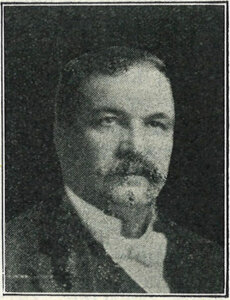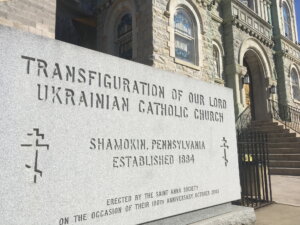WASHINGTON — The oldest Ukrainian diaspora organization in the United States, the Ukrainian National Association, is commemorating its 125th anniversary this year.
The UNA began as a self-help group that eventually forged Ukrainian-Americans into a powerful force that performed a vital role in helping keep alive the idea of an independent Ukraine during the darkest times of the 20th century, when the nation’s enemies were trying to eradicate the notion of a separate Ukrainian identity.
The beginning of mass Ukrainian immigration to the U.S. was in the late 1870s, although individuals had arrived in North America as early as in the second half of the 17th century.
Most of the first migrants came from Ukrainian ethnic lands that were then part of the Austro-Hungarian Empire and are now part of western Ukraine.
Many were recruited to work as coal miners in the state of Pennsylvania, one of the new country’s industrial powerhouses producing steel for constructing railroads, buildings and machinery that drove America’s economy and opened up its territory.
Conditions for miners were often appalling and the risks of fatal accidents or maiming high.
Irena Yarosevych, a member of the UNA general assembly, said: “In 1894, the establishment of the association was driven by the need to help the thousands of new immigrants arriving from Ukraine who worked dangerous jobs in the coal mines of Pennsylvania. Deaths were frequent, and young widows did not have the ability to pay for a funeral, much less receive future income.
“From the original ‘burial policies’ that paid funeral expenses and provided income to the bereaved families, the UNA expanded into a full-service insurance provider with tens of thousands of members.”
In November 1893, a Ukrainian-language newspaper, Svoboda (Freedom), published in the state of New Jersey, suggested in an editorial that Rusyns, a group name that previously referred to Ukrainians, should form a nationwide self-help association.
The editorial urged: “Ukrainians scattered across this land need a national organization, namely such a brotherhood, such a national union that would embrace each and every Ukrainian no matter where he lives. …in unity there is strength, and it is not easily defeated.”
In response, 10 of the brotherhoods pooled their assets, $220, and formed the Ruskyi Narodnyi Soyuz (Rusyn National Association) with 439 members in the Pennsylvanian mining town of Shamokin on Feb. 22, 1894.

Theodosiy Talpash was the first president of the Ukrainian National Association. He was elected on May 30, 1894.
Theodosiy Talpash became the association’s first president at its first regular convention held on May 30, 1894, in Shamokin. The association’s primary task then was to provide insurance to pay for a decent funeral for its members.
The association quickly grew with the Svoboda newspaper becoming its voice. As more immigrants came to the U.S., they brought with them ideas about the rebirth of Ukrainian national identity that were sweeping through Ukrainian ethnic territories in both the Austro-Hungarian and Russian empires.
Most of the first members of the association belonged to the Ukrainian Greek Catholic Church. They set about building places of worship.

The Transfiguration Of Our Lord Ukrainian Catholic Church in Shamokin, Pennsylvania. (Askold Krushelnycky)
Evolving roles
The church, from its headquarters in Lviv, sent priests to cater for the needs of the new parishes. Priests were in the forefront of educating Ukrainians in their homeland about their history and culture and some of those who came to the U.S. were equally zealous about spreading those ideas in the emerging, well-organized diaspora.
The association also organized reading rooms for adults and schools that used the Ukrainian and English languages for children of the immigrants.
The association’s most active members, whether clergy or secular leaders, were Ukrainian patriots and patriotism was woven into the fabric of the entire organization.
World War I and its aftermath led to a short-lived independent Ukrainian state and their kinsmen in the Ruskyi Narodnyi Soyuz tried to enlist American support for Ukraine.
In 1919, the organization’s name was changed to the Ukrainian National Association.
After the war, most Ukrainians found themselves living either under the communists in the newly-formed Soviet Union or within the borders of a resurrected Poland. Both the Soviets and the Poles were hostile to Ukrainians’ independence ambitions and suppressed them with brutality.
The UNA’s first aim was to ensure the security and prosperity of its members and also to make them into “good” Americans and Canadians, working through its scores of branches.
But increasingly the association realized that it also had an important role to play in supporting independence efforts by Ukrainians in the homeland.
The UNA had political influence because it could organize votes among its members for politicians who supported the association’s aims.
An early political triumph for the UNA was when President Woodrow Wilson proclaimed April 21, 1917, as Ukrainian Day, when Americans were asked to make donations to help Ukrainians suffering because of war.
Svoboda newspaper was the main means to communicate with UNA members. But as the decades passed, many descendants of the original immigrants were more comfortable speaking English than Ukrainian. So in 1933, the UNA introduced the first English-language newspaper in the Ukrainian diaspora, The Ukrainian Weekly.
The UNA parleyed its political influence to make America and the world aware of Ukraine, even when Ukrainian voices were savagely silenced at home. During the inter-war years, UNA members protested against Polish repressions of the Ukrainian population within their borders.

Father Mykola Ivanov and parishioner David Kaleta stand outside the Transfiguration Of Our Lord Ukrainian Catholic Church in Shamokin, Pennsylvania. (Askold Krushelnycky)
Holodomor alerts
The UNA told the world about millions of Ukrainians being starved to death by Soviet dictator Josef Stalin.
In 1933, some of its members, in cossack garb and carrying American and Ukrainian flags, rode on horseback through Detroit to draw attention to the Holodomor, then reaching its murderous peak.
As World War II erupted and thousands of UNA members joined the American and Canadian armed forces, the association worked to ensure that Ukraine’s interests were not forgotten.
A wartime editorial in The Ukrainian Weekly said: “Today, in exerting all their energies to help our country win this war against the Nazis and Japs, the UNA and its members find inspiration, too, in the cherished hope that when victory is won and tyranny dethroned, the Ukrainians over there will be given an equal right, with other enslaved peoples, to establish their own independent Ukrainian state. That is their inalienable right. And to the upholding of that right the UNA has been dedicated from the very first days of its existence.”
Ukraine did not receive independence after World War II, but fell under Soviet domination and a Cold War standoff began.
A great achievement by the UNA during the 1940s was its campaign to prevent Ukrainian displaced persons in Europe being forcibly sent to the Soviet Union, where many would have faced persecution or execution. Instead huge numbers came to North America with the UNA playing a big part in bringing them over and helping them get settled.
The UNA, and other diaspora organizations, had to continue the work of ensuring that Ukraine remained a presence on the world stage. America was the key Western country that needed to be made aware of Ukraine’s interests and the UNA performed that role diligently.
The UNA has many other achievements. It established the Ukrainian Research Institute at Harvard University. In addition to publishing Svoboda and The Ukrainian Weekly, it published a children’s magazine, and sponsored Yale University Press’ publication of Mykhailo Hrushevsky’s seminal book “History of Ukraine.”
It helped British historian Robert Conquest publish his book, “The Harvest of Sorrow,” which brought the horrors of the Holodomor to the attention of an international audience.
The UNA donated funds for the U. S. Commission on the Holodomor and the Harvard Project on the Millennium of Christianity in Ukraine. It has provided, and continues to do so, scholarships for college students in the U.S. and Canada.
The association organized the erection of a statue in Washington, D.C., to heroic poet Taras Shevchenko. Such monuments require government permission and the UNA used its political clout to gain a prominent area in the capital’s embassy district for the statue unveiled in 1964 by former U. S. President Dwight Eisenhower.

Dwight D. Eisenhower, the former U.S. president and military general, unveils a Taras Shevchenko statue before crowds in Washington, D.C., on June 24, 1964.
As different Ukrainian groups sprang up, the UNA helped form the Ukrainian Congress Committee of America, the largest diaspora organization in the U. S. It was instrumental in the creation of the World Congress of Free Ukrainians.
Its membership grew in the 20th century to number some 42,000 during World War II and peaked in the 1970s with 90,000 members. In 1994, it had 64,000 members and currently has about 50,000 members in the U.S and Canada.
After Ukraine’s independence, the UNA created a fund to support projects there such as school textbooks and handbooks for businesspersons, and helped train English-language teachers. It had already opened a press bureau in Kyiv in January 1991.
UNA’s national secretary, Yuriy Symczyk, said that the UNA today has a two-fold mission: offering its members life insurance products and helping them “become better Americans and better Canadians in their new home countries while not forgetting about their homeland, Ukraine, and their heritage.”
He said the UNA, as a fraternal organization, has a responsibility to bring together the new waves of Ukrainian immigration with generations of Ukrainians living in U.S. and Canada and to support as many of the other Ukrainian community organizations and events as possible.
Symczyk said profits from UNA’s insurance products go directly to provide benefits to UNA members and to Ukrainian communities. The UNA, he said, decided that it would focus on its publications and grow the endowment fund for them.
The UNA is holding events throughout the year at different branches to commemorate its anniversary. These started on Feb. 22 when the association’s president, Stefan Kaczaraj, and other leaders visited Shamokin, where the UNA began. The events culminate in a grand concert on Nov. 2 in Morristown, New Jersey.



